We all have a story to tell; why we are passionate about the Rouge River, how we got involved with FOTR… Share Yours Today!
Press here to submit your story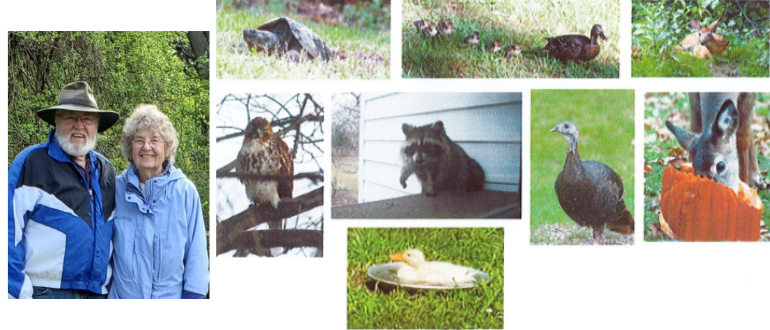
By Douglas Wallace
I was born in Plymouth, Michigan, in 1941, at the Plymouth Hospital which was located on South Main St. As you are undoubtedly familiar, Plymouth was a small town back then located within the drainage area of the Middle Branch of the Rouge River.
Once I graduated from a tricycle to a two-wheeler I found Edward Hines Park, more specifically the wading pond on the northwest corner of Park and Hines drive; circa 1946. The site is now just a plot of grass. I tried to secure a picture of the old pond, but the Wayne County Road Commission folks could or would not find a picture of the pond during and/or after its construction which, I’m guessing, would have been in the later 1930s, when the several now historical restrooms along Hines Drive were being built.
On Labor Day in 1948 our family moved into a cinder block house my father built in Livonia township; it was on about 3 acres at the junction of Stark Road and the Middle Branch. In short order I found the river and some of its inhabitants. While pursuing the slow-moving mussels I got some river water in my left ear, which led to an infection and a broken eardrum. Off to the doctor in Plymouth ,who pulled out a sizable hunk of wax, which he showed to me saying “doesn’t this look just like a horse?” I might have agreed if I was not in such a painful state. Following a sequence of warm oil drops into the ear I was back to the river, albeit a bit more cautious! I tried building a raft using nearby timber only to find that ironwood timber does not float, even with innertube assistance!
The section of Hines Parkway between Ann Arbor Trail and Newburgh Road was the final section of the parkway; circa 1950. The river was rerouted in several locations and the stretch between Stark and the Wayne Road bridge was fashioned into a perfectly flat quarter-mile unofficial drag strip. The development of this strip required the repositioning of a power pole which I observed closely, as they had to bore a hole some 20 feet into the clay so that the pole would survive the yearly flooding. The clay that was brought to the surface was a nice blue color. Now the color “rouge” is not a “blue” color, but it is the color of one of the clays that lies beneath the Middle Branch at Stark Road. I took a sample of the clay to my 3rd grade teacher, who was into the arts, for her inspection. I created an ashtray (appropriate for the period and easy to create); painted it with multiple colors after it dried and I subsequently lost it along with my Classics Comics books!
The county repainted and re-planked the original trestle bridge circa 1949 only to remove it and place it across the river across from the Nankin Mills nature Center. The bridge is now closed because of a rotted-out deck and possibly because the Sheriff patrol didn’t want to traverse the back roads.
Removal of the bridge meant that us young folks who were attending Stark Elementary School at the intersection of Pine Tree and Stark Road could no longer walk the quarter mile to get to school. We had to walk a quarter mile to catch a bus which would take us on a three-or four-mile tour before dropping us off at school. We were not the only ones inconvenienced by the bridge removal. At the time, there were three horse stables within a two-mile radius of the bridge. Horse riding folks in the North could not get across the river safely to access the bridle trail!
My father began writing letters on his Royal typewriter, sending them to whoever he thought might have some influence regarding the placement of a footbridge across the river at Stark Road (the County did not want any cross traffic on their new strip of concrete). After 7 months of correspondence with representatives from various levels of government and the road commission a footbridge was installed. The current iron bridge is version number 3.
On Christmas Day, 1950 I received a Kodak Brownie camera. Rushing outside I took my first picture, it was of the Stark Road bridge – footbridge version number 1 was a nice rustic structure, but it aged out prematurely. Moving into high school, I became a photographer for the high school yearbook. The two pictures on the right were used as seasonal separators in the 1958 Livonia Bentley yearbook.
Following high school graduation, I joined the Air Force, and given normal military protocol I was not able to spend time in the Rouge watershed – Clark Field in the Philippines would have been quite the trek. Once reassigned stateside, the trip home to Livonia from Fort Mead in Maryland was made as often as possible. An “early out” from the Air Force was obtained, despite a threatened delay due to the “Cuban missile crisis.” I was accepted into a program at Eastern Michigan University. I took up residence in the house that I helped my father build during my adolescent years; in fact, the new house was closer to the Stark Road bridge crossing than our former cinder block residence.
Prior to the beginning of classes at EMU those of us who were going to be “commuter students” were invited to attend a “commuters council” and take a tour of campus. I attended, as did one Sandra Czerwick. We hooked up and managed to finish the tour. It turned out that she was also a Middle Branch aficionado, as she would ride her bike from the western portion of Dearborn over to Ford Field which was adjacent to the Middle Branch. As a community college art student, she painted an abstract of the industrial area at the mouth of the Rouge.
Some 57 years ago we married, and we both graduated from EMU. In 1971 I secured a Ph.D. from Wayne State University. We then moved away from the Rouge to Richmond, Virginia, and then to California for 35 years. Our visits to the Rouge became limited to holidays, weddings, and, unfortunately, some funerals. On one of my visits to the Stark Road family home, I learned about the formation of the Friends of the Rouge, to which I began contributing.
After one such trip, I received a call from Cyndi who wanted to know how I knew about the Rouge River, given that I was living in California. My initial somewhat snarky response was – “how about one broken eardrum!” I then filled her in with a few relevant details.
Sandy and I both retired in 2007, with a little help from the Social Security office. We packed up and returned to my family house on Stark Road, arriving on Tax Day in 2008.
Seeking to become involved in something positive, we attended a Bug Hunt training in 2009 and became co-team leaders. We persisted in sampling various sites through heat, floods, and snow. In 2010 I took the frog and toad survey training and managed to last a few seasons – the only critters that would sing in my assessment area were American Toads in original Rouge waterbed and Leopard Frogs in a former skating pond next to the river; the vernal pond was later populated by phragmites, and in the absence of annual flood water it dried up.
In 2016 Sandy and her co-planter Jennifer Petoskey, began the creation of the Pollinator Garden at Merriman Hollow. I was the water-works engineer for several of the plantings. I put together a sump pump with a 2-inch output, powered by a portable generator and pumped water from the adjacent river so that the volunteers could water the new plantings; of course, the plantings were subjected to the usual flood-plain waters later in the year!
We both attended the advanced stonefly training in January of 2019, and during the first Stonefly search we discovered “The Ax.” I don’t recall finding any stoneflies despite using a spud bar to chop through 3 layers of ice.
Not to be deterred, we unofficially sampled our local branch in 2020 and found a gill snail; imagine finding such a snail in the Middle Branch, it certainly wouldn’t have happened in the 1950s! The advent of Covid-19 was disruptive to most sampling opportunities during the 2020-2021 period. I chose to hang up my sampling boots in 2022 as aging processes were beginning to take their toll and I thought it was prudent to begin to enjoy the river visually rather than physically.
Our front porch is about 120 duck-waddle feet from the Middle Branch of the Rouge. I, along with Sandy, will continue to learn and appreciate all that the river has to offer so long as we are able to traverse the distance.
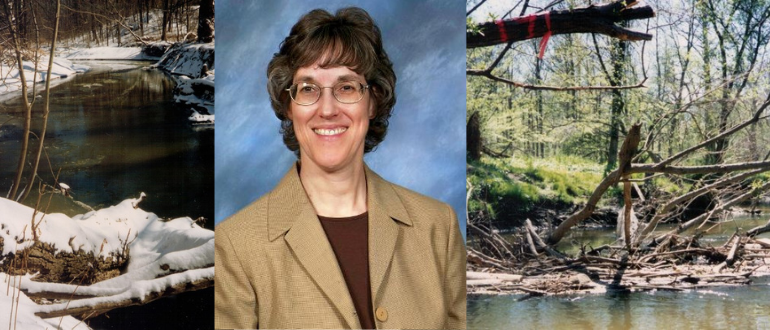
By Sondra Willobee
11/30/2021 Southfield, MI
In June 2006, our daughter Laura spent her 21st birthday wading in the muddy water of the Middle Rouge River. We’d signed up to work at Rouge Rescue, an annual clean up of the Rouge River watershed in southeast Michigan. The 127 river miles in the watershed included a stretch through our Southfield back yard.
During Rouge Rescue, volunteers break up log jams, pull out garbage, stabilize the streambanks, and remove invasive species. It isn’t uncommon to find shopping carts or tires in the river.
The Rouge has many problems. Besides residential and industrial pollution, stormwater running over streets and parking lots fills the river with toxins, bacteria, and oil. Fast-moving runoff also causes the water to rise too quickly, eroding banks and washing away vegetation.
We remembered the aftermath of several storms when the floodplain behind our house completely filled with brown water. We carried our canoe down the hill and paddled among the trees. It was fun, but we knew the flooding wasn’t good for the river.
However, after thirty-five years of Rogue Rescue, river conditions have improved. This fall twenty-five kayakers paddled the Lower Rouge Water Trail in Dearborn. They saw Great Blue Heron and evidence of beaver.
Sometimes people need the same kind of help that rivers do. In his novel, The Brothers K, David James Duncan said that there are some kinds of human problems that “gently rob us of just enough energy or faith so that days which once took place on a horizontal plane become an endless series of uphill slogs.”
Read the full blog post “Rescue” on Sondra’s blog
Read Sondra’s other Rouge River related blog posts:
Early Warning– Feb 7, 2022
Ax– Dec 15, 2021
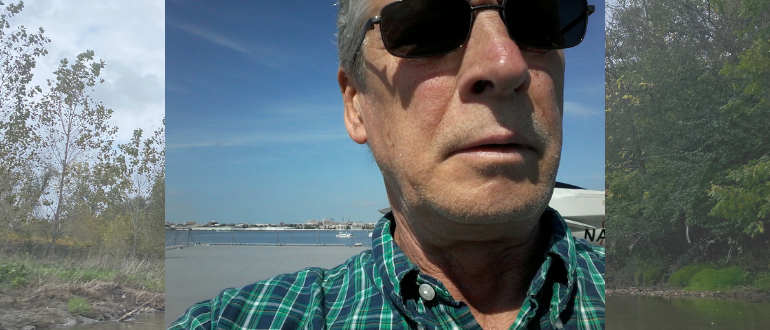
By Steve Jinks
11/1/2021 Redford, MI
“My stretch” of the Rouge extended from just south of Grand River in Grandlawn Cemetery to ex Bonnie Brook Golf Course south of 8 Mile. I played on, over, and around the river. I lived just off Grand River a couple of blocks from the river. A friend and I would “appropriate” a cement tub from Boston Tile and carry it thru the alley and then down G.R. to the bridge and onto the water where we were Huck Finns on a raft! I even made an 8mm film called “The Chase” down by the river. I have always wondered though about the gazillions of small red worms protruding from the banks and if that was why it’s called the Rouge.
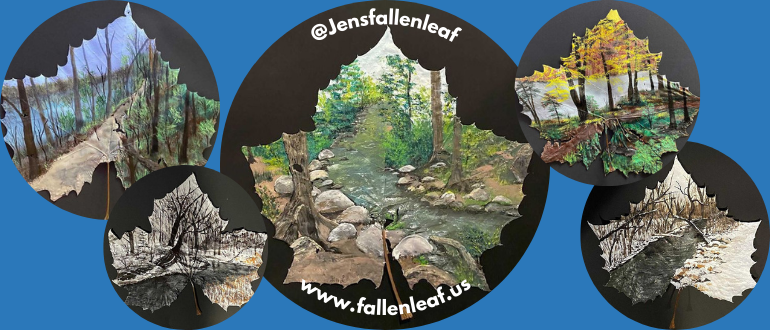
By Jennifer Lanzilotti
10/6/2021 Plymouth, MI
How lucky I am as an artist to be living so close to the Lower Rouge River Recreation Trail! It is my happy place, where I love to walk and run and restore my soul. The quiet trail, where there are no automobile sounds to interfere and distract, is truly an artist’s paradise. For me, the blessing is double. Nature is my inspiration, and the heavily wooded trail provides so many beautiful scenes that I can turn into some of my best paintings. If that weren’t gift enough, I can gather the perfect fallen leaves that will become my canvas. Walking there in the Fall helps to replenish the leaf supply that I will use for the coming year, while all the seasons provide me with inspiration and feed my constant need for the beauty of nature.
This section of the Rouge has been restored from its earlier industrial condition into a far more pristine experience of nature. I thank all those Friends of the Rouge for the years of cleanup and hard work that have restored this area to its natural beauty. Its benefits are for everyone, and I am one who is truly grateful to have this special place to paint and enjoy every single day.
Check out Jennifer’s art:
@Jensfallenleaf on Instagram
Jen L. Art on Facebook
https://www.fallenleaf.us/leaves.html
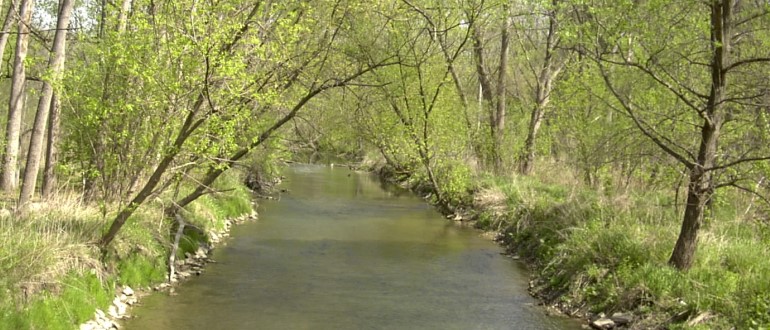
By Ruth Moline
9/17/2021 Southfield, MI
I have lived almost fifty years by the Rouge — twelve in the apartment complex separated from Beech Woods by the river, twelve in Old Redford on a three block street with the Rouge across from our front doors and twenty-five [years] about three blocks from Hines Drive. [My husband and I] were active in keeping our street and the bridge at the foot of it clean of trash and worked the Rouge Rescue days from the first such events in the 80’s. My husband used to bicycle down by the bridge to tell people not to dump their trash, noted license plates of dumpers and called DPW about dumped trash. You’re doing a great job of caring for the Rouge, [Friends of the Rouge]. Keep it up.
By Jaclyn Heikkila
9/9/2021 Dearborn, MI
A Rouge Haiku
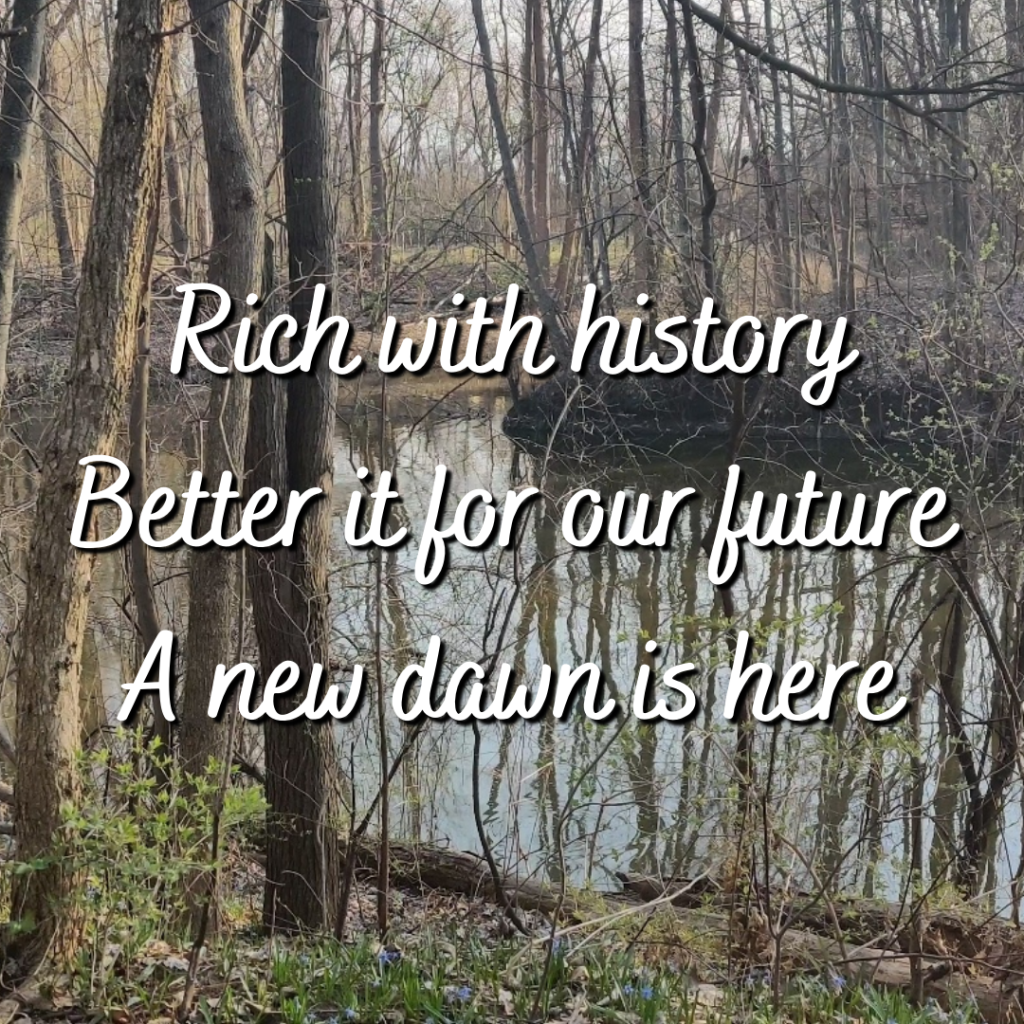
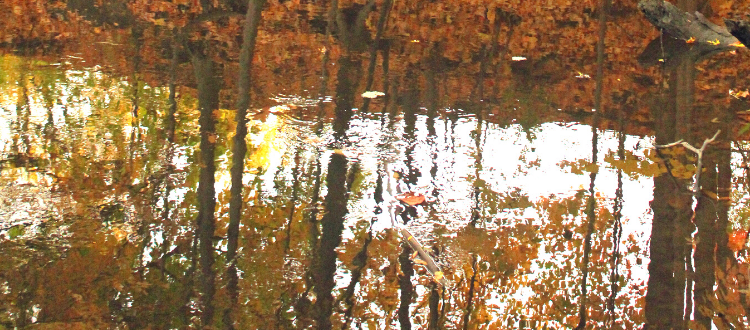
By Scot Martin
2/10/2021 Redford, MI
Let’s face it: the Rouge River is not a scenic river and will probably never receive that designation (though we can hold out for hope).
In fact, part of the river and its encompassing riparian areas are downright ugly. Bare earth in the floodplain that has its ground cover continually drowned or washed away; great patches of common buckthorn and garlic mustard; trash. The Rouge flows under overpasses and by all assortments of commercial spaces (a plethora of ever-enchanting parking lots, for one).
But…for those who have eyes to see–beauty can be found. And perhaps, most importantly–it’s our river. We inhabit this watershed–the Rouge is ours and we are hers.
Thus, if you follow author and farmer Wendell Berry’s dictum: “The first duty of stewardship is to know and respect what is there.” That knowledge can lead to love.
Again, she is no Pine or AuSable River; she doesn’t have the power of say, the Snake River in Wyoming, but still, she is ours.
Ours to cherish and protect. She births dragon and damselflies, redside dace and bluegill, frogs and toads. She provides sustenance for raccoon and red-winged blackbirds, and even recently, beavers.
Sure, she’s plagued by turbidity, flashiness, and invasive honeysuckle in many runs, but she is ours to restore to glory.
We have helped to bring the Rouge back from a fiery dump at her mouth (how many cars and shopping carts have been pulled from her bed?), envision what we can assist in another 50 years.
The Rouge is our river. Our watershed. And we are hers.
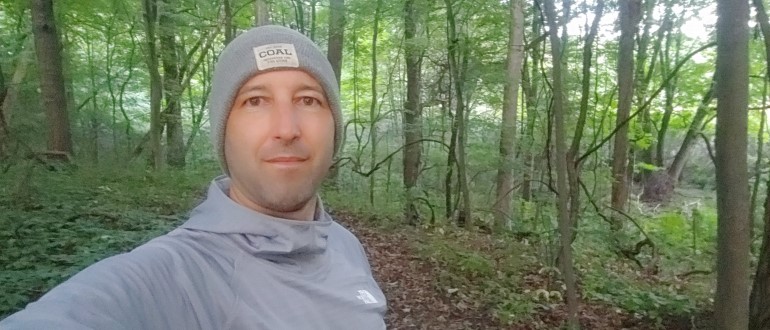
By Kayne Karnbach
1/27/2021 Dearborn, MI
My son and I moved to Michigan in summer 2018 (Dearborn in 2019). I first got introduced to FOTR through my job at the Detroit Zoo. We have volunteer days and one of the options was to do a cleanup with you all. I did a lot of river cleanups and general trash cleanups in VA. I also led some major cleanups and water quality education programming while working in VA. I wanted to get back into it as a volunteer after moving to Michigan. We volunteered in Dearborn, ironically, when I did the volunteer day with the Zoo.
My son donates part of his allowance and I encouraged him to make a donation to a local organization. Since we had kayaked with a friend on Rouge and spent a lot of time enjoying the river when at Ford Park, I thought it would be nice if he made a gift to you guys. Outside of my support, I have bought two rain barrels and some native plants. I think it’s important to support local organizations that are working to make a positive impact in my backyard.
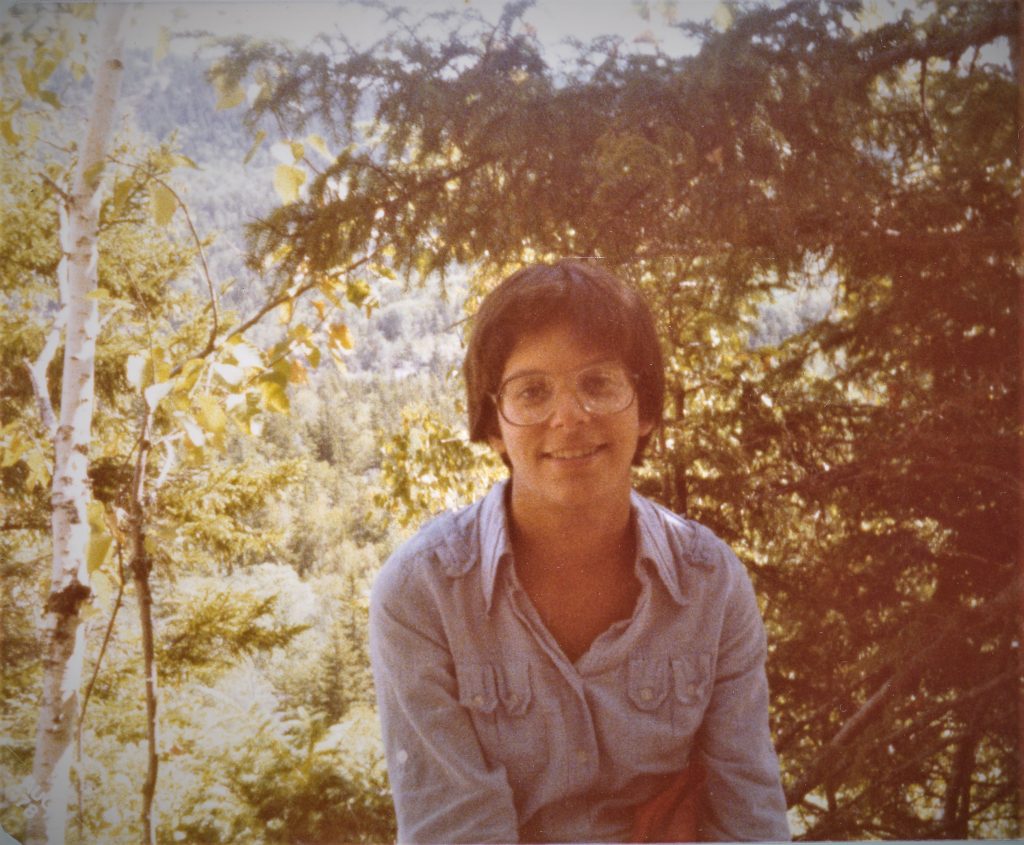
By Wynn Wargo
11/4/2020 Clearwater, FL
I grew up along the Rouge River, near the Dearborn Hills Golf Course. I can remember its pungent smell, upstream from the major industrial polluters. I always wondered why it smelled like that. I knew why it smelled down by Delray! I hope my memories may spur others to share our heritage. The Uncruise was of particular significance in my heritage. My mother came of age in Delray in the 1930’s through the early 50’s. My father was a Superintendent in Ford Motor Company Steel Division from the late 1940’s through 1970. I grew up in West Dearborn, and attended many concerts at the Coffeehouse held in the basement of the Fairlane Estate in the early 1970’s.
My Earth Science class at Adams Jr. High spearheaded an ill-fated protest against the development of the Fairlane Town Center in early 1970. Wayne S. Doran, President of Ford Motor Land Development, spoke to our 9th grade class. He looked around and muttered, “Oh, these are the bosses’ kids. That’s why I’m here.” It wasn’t just a bunch of 9th graders protesting. An ad hoc group formed in early 1970—Save Our Woods or Save Fairlane—and circulated petitions at Westborn Shopping Center and other locations. Maybe some real old time Dearbornite activists will recall our doomed campaign to prevent the development of Fairlane Town Center. We wept as the Lower Peninsula’s lone virgin birch forest vanished forever. Many of my Adams Jr. High classmates lived adjacent to the Fairlane Woods and knew its exact location. I never had a chance to see it before it vanished. I wish we had it back so we could pass it along to our children and grandchildren.
A response from Dr. Orin Gelderloos, retired Professor of Environmental Sciences & Biology at UofM Dearborn:
The virgin forest that Wynn Wargo mentions is probably the American Beech forest on Evergreen and Hubbard Dr. (Gildow Road at that time) and Ford Road which was scheduled to be cut down (razed) for condominiums and the Fairlane Club. An Assistant Attorney General of Michigan developed proceedings against Ford Land to stop the massacre and building project. Ford hired Dr. Donald Eschman, Professor of Forestry at UM-AA to survey the forest. He commented that a forest of this quality was becoming more rare in southern Michigan and would be a value to the quality of the community. After the survey, I asked someone involved with the project what Ford Land did with the report. Their comment was a shrug of the shoulders and a statement that they put it on the proverbial shelf.
The result was that the AG’s office reached a compromise with Ford Land which we see today. They left a border of trees around the condos and Fairlane Club, which lowered the traffic noise pollution and raised the quality of the condo living thanks to the citizens’ protests. I felt that the citizens should have sent Ford Land an invoice for consulting fees for improving their property. As you know the Club Building is now part of UM-Dearborn and the tennis/health club is closed. My wife, Char, and I did a survey of the American Beech trees in a sample area from Evergreen along Hubbard Dr. to the condo entrance last March (2020). An impressive collection of American Beech trees of all sizes are growing in that woodlot/forest indicating that they are reproducing and can remain for generations. In addition, the palette of autumn colors on the trees along the intersection of Hubbard Dr. and Evergreen Rd. are stunning and bring great pleasure to the drive-by. We can be grateful for the change in attitudes about the importance of vegetation and habitat preservation of the past one-half century.
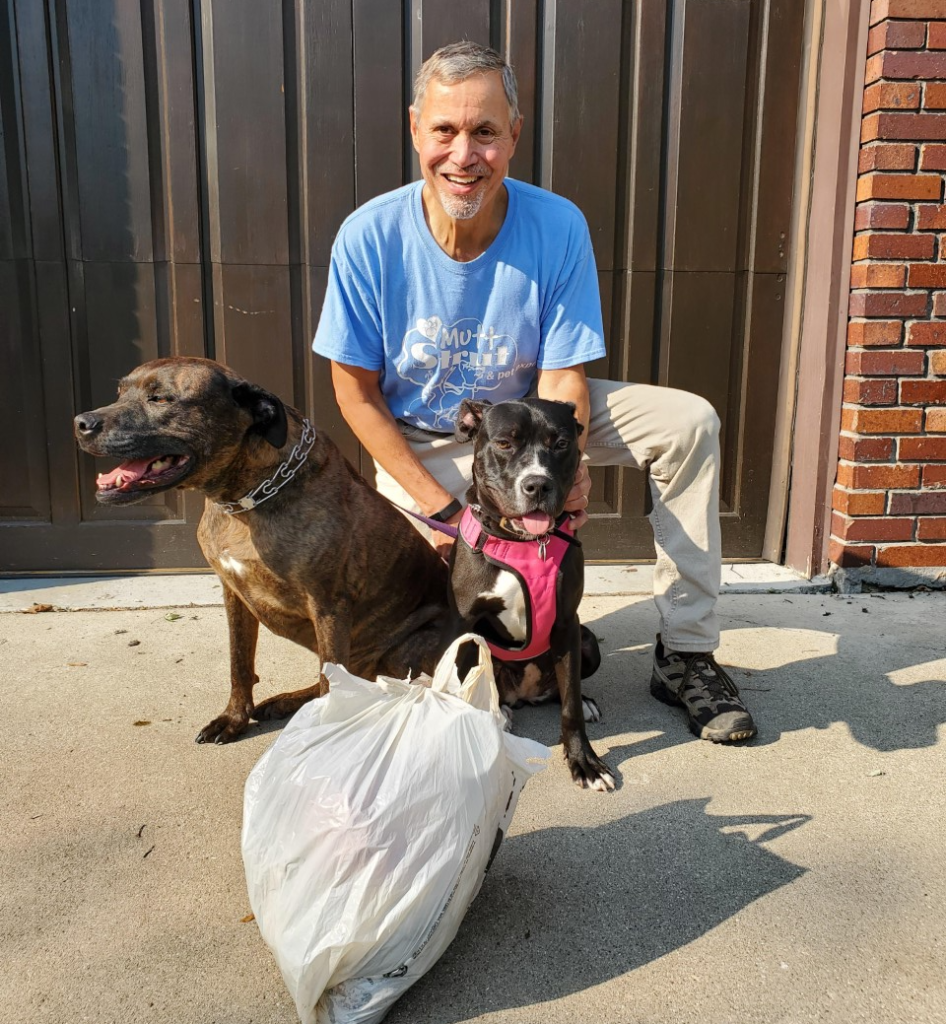
By Kevin Green
10/21/2020 Dearborn, MI
The Lower Rouge River Basin has been a major part of my life for more than 50 years. I fondly remember spending time as a child and teenager playing basketball, tennis and hockey (we built and shoveled our own ice rink) at Perrin Field, playing baseball and swinging on a rope over the Rouge at Nolar Bend, and going sledding on Deadman’s Hill (now Middlebelt Hill), all in Hines Park. As an adult, I spent many hours riding and racing bicycles on Hines Drive, from one end to the other (and beyond), as well as golfing at Warren Valley and Dearborn Hills. My son and I also worked on several Rouge Rescue Days with our church and the Boy Scouts. For almost 30 years, my wife and I have owned many homes near the Rouge. These days, my dogs and I frequent the Gateway Trail, the trails behind First Presbyterian Church and Dearborn Country Club, and the trail along the Rouge from Ford Field to Outer Drive. On these walks, in addition to enjoying the flora and fauna, we have taken on a mission of helping to clean up after the many people who apparently were never Boy Scouts and/or didn’t learn the lesson of “always leave a place better than you found it.” Specifically, we collect trash, frequently filling at least one grocery bag with garbage and recyclables (bottles, cans, cups, etc.). In fact, it’s not unusual for us to collect 10-20 recyclables on a single walk (we picked up 11 on the day I wrote this article). For the sake of the River and its many furry, feathered and aquatic inhabitants, as well as our fellow humans, I implore everyone to pick up after themselves, using the trash receptacles along the way or taking your trash home for proper disposal. If we all do our part, the Rouge Rescue can be a daily, instead of just an annual, event! PS Please pick up after your dogs, too!
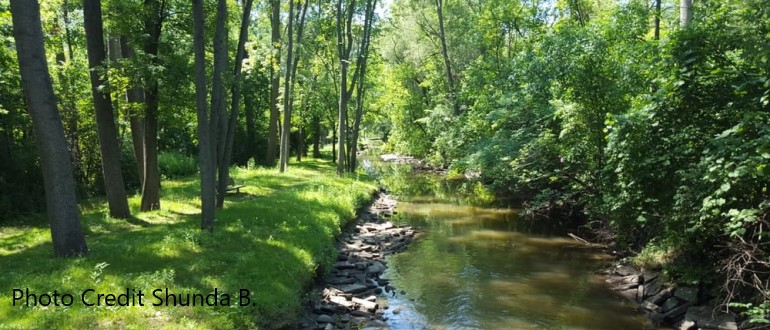
By Peggy Collins
9/09/2020 Southfield, MI
I arranged for a water blessing of the Rouge [River] where it runs in Southfield at Valley Woods [Nature Preserve] (Telegraph and Civic Center Drive). I invited a tribes member from SW Michigan to lead us (we were able to pay her). There were about 30 people taking part.
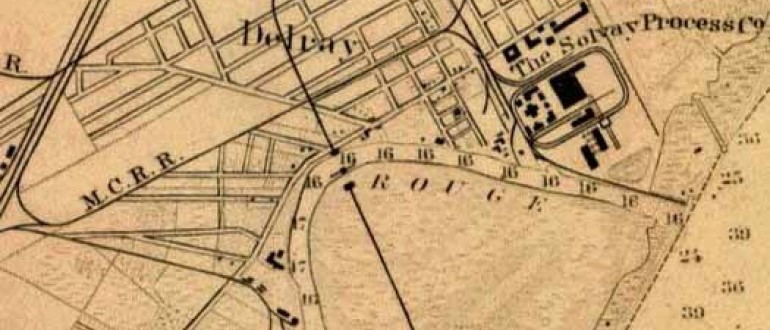
By David Nowlin
8/26/2020 Livonia, MI
My parents both grew up in Delray and I spent a lot of my childhood in Delray. It is sad to see it now compared to the memories from my youth. My grandparents lived one block off of Jefferson and we could hear the boat whistles from their house and would go running to the foot of Dearborn Street to see them pass by in the canal. I also worked 32 years in the Ford Rouge plant with many of those years in the Power House which used the water from the Jefferson Screen House to cool the condensers for the three steam turbines that drove the generators that produced the power for the Rouge complex.
Want to learn more? Read Shawn D. Lewis' recent Detroit News article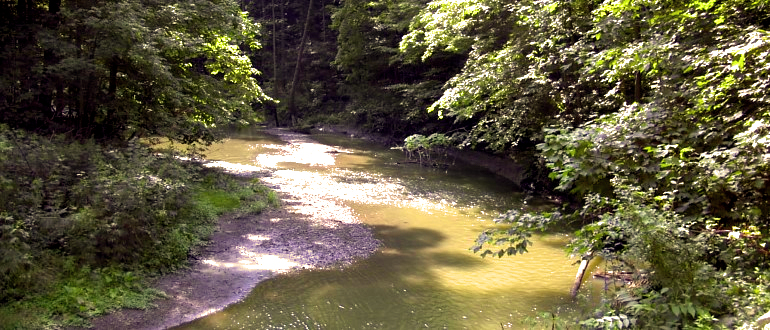
By Carol Oz
8/12/2020 Mokelumne Hill, CA
I vaulted into an environmental protection career due to early bike rides along the Rouge. My big brothers told me not to touch the water or my hand would fall off [due to pollution]. I craved a clean River I could swim and play in. Later, when I found there were rivers and lakes in this world you could swim in, I thought wow. Let’s try.
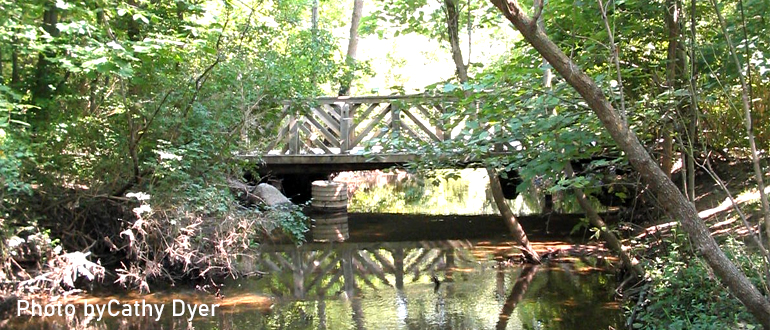
By Cathy Dyer
7/29/2020 Ann Arbor
You know you have to write your “Rouge Story” when you move 20 miles away, and start telling your friends that you’re excited to move to your first house, but you’re sad that you’re leaving your watershed!
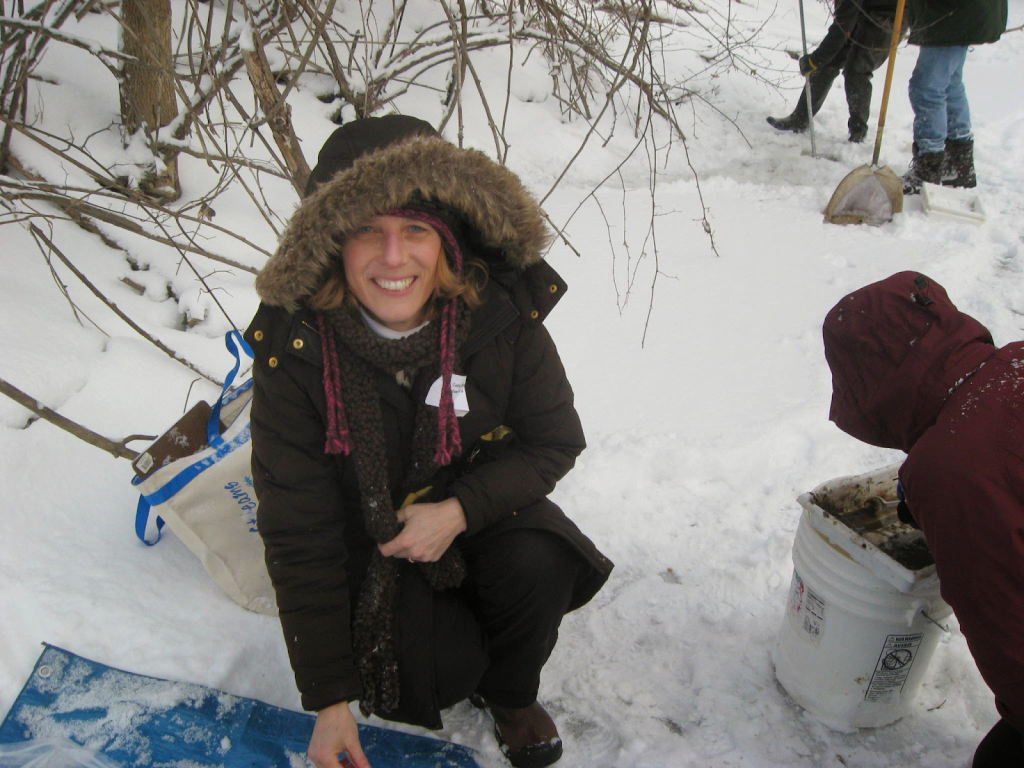
Most of my life has been lived on the developed land entwined with and fed by the Rouge. Growing up I played first near Lola Valley Parkway in Redford, and then in Livonia where my brothers and I explored along the nearby paved creek and then later the more natural ones.
I tolerated the garter snakes my brothers caught at Bell Creek and kept in the garage one summer preferring to climb my maple tree in the backyard. One way I see the suburban areas where I have lived, is as an interplay of the rectangular houses on the straight swaths of cement with the branches of the curving Upper Rouge. I walked and drove along the pavement, but my heart moved along the river.
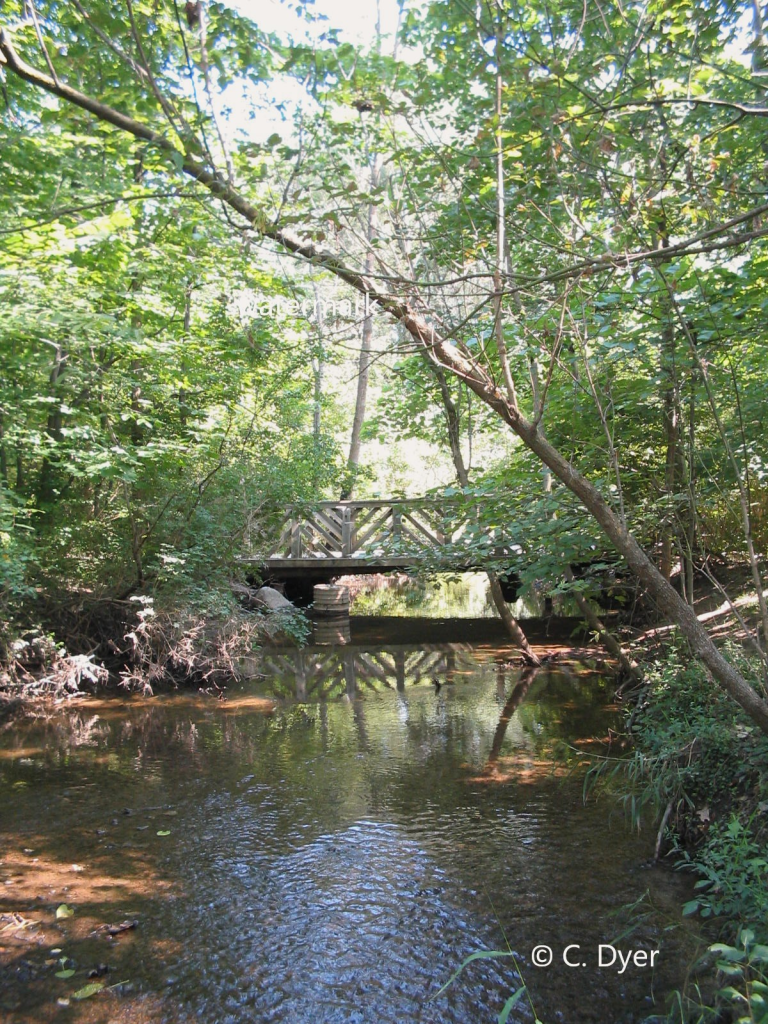
Soon my river connections moved beyond play. In the Girl Scouts we visited Nankin Mills Nature Center and hiked at parks including the then new Rotary Park in Livonia. What I most remember about it was the mud! This was before any pavement or sports fields in the area in front of the forest and river. At Dickinson Junior High School my biology teacher got us involved in one of the first river cleanups pulling trash out of the long-ignored river. I remember being excited and energized by doing something for the outdoors. These awakenings would bring me back to the river later.
As a young adult I lived and taught elementary students in Puebla, Mexico and San Antonio, Texas for a while, but I found my way back to the Rouge in Northville and Plymouth in the mid-1990s. By that time, many of the Rouge road signs had been installed. These signs appeared in so many places that they got me curious about how all the parts of the river were connected. Did the creek I lived by in one part of Livonia flow into the one where I lived when I was in high school? How did the sign near my apartment fit into this watershed? I saw a Rouge Cleanup advertised and decided to participate.
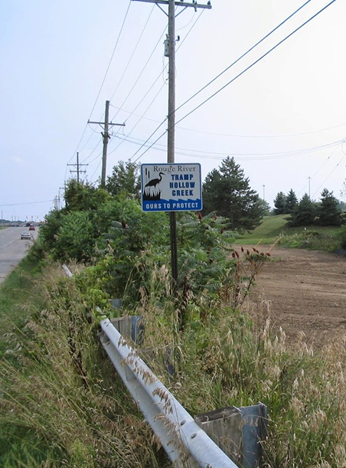
I was so happy to be back in the familiar tall Michigan trees, and the four seasons after years in very different ecosystems. That, and the hopefulness of the Rouge doing much better than it was in the 70’s, called me to learn and do more.
I spent a couple of summers driving and hiking to about ninety places on the Rouge. I eagerly explored from Firefighters Park in Troy to the Kosch Headwaters near Ypsilanti to Rouge Park in Detroit and many others in Canton, Farmington Hills, Southfield and Walled Lake. I explored and took photos. Then I marked my sites on a 3 x 4 foot map of the watershed with push pins.
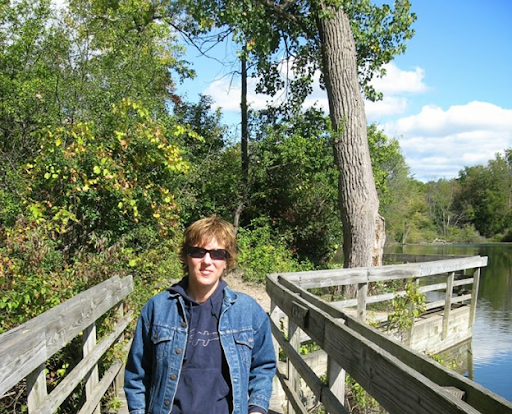
Other days I searched and read at libraries for stories of the Rouge’s past. I discovered French sledding parties and horse races on the ice, as well as cheese making, brick making, and of course, the old mills. Then I started attending naturalists’ programs at parks: about trees at Bennett Arb, ferns at Holiday Park, butterflies at Rouge Park and birds at Heritage Park. I kept going to Rouge Rescue clean ups too. I can honestly say that tickets to a musical concert didn’t get me as excited as the chance to go on the first public canoe trip on the Rouge in Westland. Even though we had to portage around many fallen trees, you could feel that all of the efforts by so many people were bringing the river back into the lives of the community. We were connecting the points into a flow.
The river tugged at me so much that I switched from teaching high school Spanish to teaching about nature and the environment at a nature center. My desire to help the river led me to create rain gardens at my home so less storm water from my property ends up eroding the banks of the river and flooding homes downstream. I still wanted to know more so I got a master’s degree in the teaching of environmental science. Even though I had moved to the Huron watershed, I maintained my connection to the Rouge. For one project I mapped some of the rain gardens in part of the watershed- this time with digital push pins! Even the extreme weather of the 2014 stonefly search didn’t dampen my call. I seemed to have caught a river bug. I made felted Rouge fish art through felting and I ran a Meetup for hiking in parks near my current river home.
To me, a watershed is so much more than its basic definition as a drainage area. It’s a community of plants, animals, fungi, people and more, all held together by the course of the river from the headwaters through the forests and wetlands, over the lawns and fields and houses and factories. Recently, I have broadened my connection to include our larger watershed, the Great Lakes/ St. Lawrence, but I still love and support my home watershed. I hope to travel following the route of a drop of water from our community all the way out to Lake Erie, Niagara, Montreal and Quebec and out to the ocean.
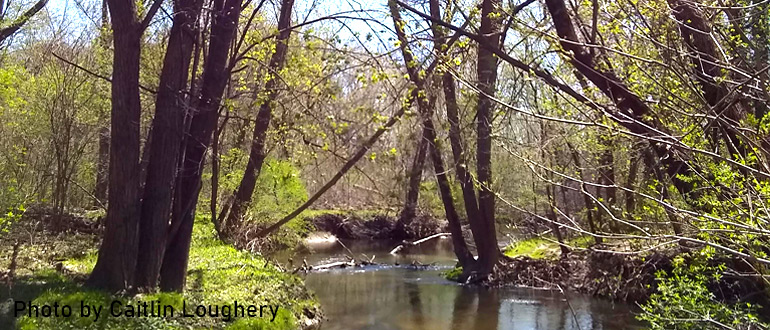
By John Deslippe
7/15/2020 Farmington Hills
I have always loved exploring nature and in my youth the Rouge River floodplain provided opportunities to interact with forest, meadow, riparian, and wetland habitats. I spent many days climb Ash and Maple trees in Rouge Park and escorting turtles that found they’re way unto the ball fields at Parkland Park to safety. Each year, with inundation from spring rains came sanitary sewer overflows and fish and bird die offs. As a child, I associated this with industrial pollution and the auto industry.
Today, I realize that the biggest contributor to water quality impairment is non-point source pollution- runoff and associated contaminants from each and every roof and driveway, roadway and parking lot. As an ecologist, I work in the urban setting focused on implementing solutions to stormwater runoff and restoring health to ecosystems. I am passionate about the work FOTR does because I know that education and informed, involved citizens are an essential ingredient in long-lasting and meaningful restoration.
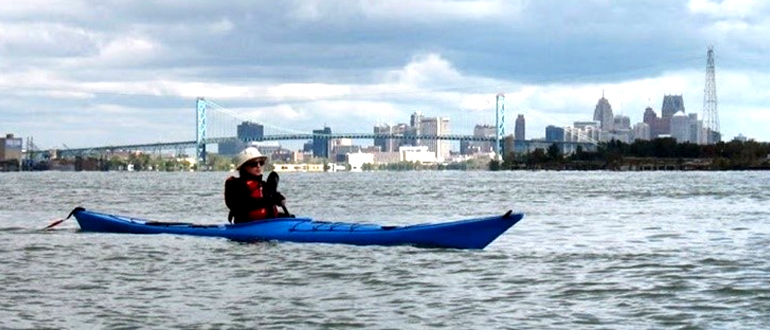
By Kathy Klein
6/15/2020 Dearborn
I grew up downriver in the 70’s, in the shadow of the Uniroyal Tire and Thunderbowl Lanes, in Allen Park and Melvindale, one of the many working-class communities of SE Michigan. If the wind was from the north or northeast we could often smell the industry of the steel mills, the Rouge complex and the wastewater treatment plant. A trip over the I-75 bridge over the Rouge River always fascinated me because of the view of industry, Canada, the rivers, pollution — it was fascinating.
This was my little corner of the world. Reecks Drain, a part of the Ecorse Creek watershed in Allen Park was my “great outdoors”. This is where I discovered my love of nature. Every day after school I would rush back to “the crick” as we called it then. It ran along my school yard and we had many Gilligan’s Island and Huckleberry Finn themed adventures. I’m sad to say it is now fenced off, so children are separated from it by an 8 foot chain link fence. Kids no longer have easy access to it like I did as a child. I will never forget all the “soakers” (falling in)…never mind how polluted it likely was back in the early 70’s!
Our little backyard in Allen Park also had the best climbing tree. That great maple tree had the most amazing arms for climbing and roosting in. It was almost as if that tree was meant to hug the many children that would grow up in that house – and there were six of us.
I don’t know if this early experience is necessarily what inspired me to be in the profession I’m in, I feel I fell into my career more by accident and opportunity than a goal I set out to accomplish…but I couldn’t be happier about where happenstance has taken me for the last 30 years. Being in the waste industry gives you an archeologist’s perspective on humanity. How we live, how we have become disconnected from our waste generation and our role in environmental responsibility…and fortunately, how we are reconnecting. I love being an educator and spending time with other naturalists and watershed professionals, all of us working to make the world a better place.
I was thrilled when I finally got an opportunity to kayak the Rouge River with Friends of the Rouge. After years spent near this river, crossing it many times over I-75 or to go to the office with my dad on the weekends, he worked in transportation at a trucking terminal in the neighborhoods around Marathon. I’m thrilled that people are being given an opportunity to get up close and personal with the Rouge again, whether by kayak or picnics on Heine’s Drive, and the new Frog Island Park near Marathon. The quality of the watershed has greatly improved through the efforts of organizations like Friends of the Rouge. Thank you for the important work you do.
By Laura Wagner
6/15/2020 Dearborn
Share a special memory of the Rouge River and the delight of Winnie the Pooh, with Friends of the Rouge Board President, Laura Wagner!
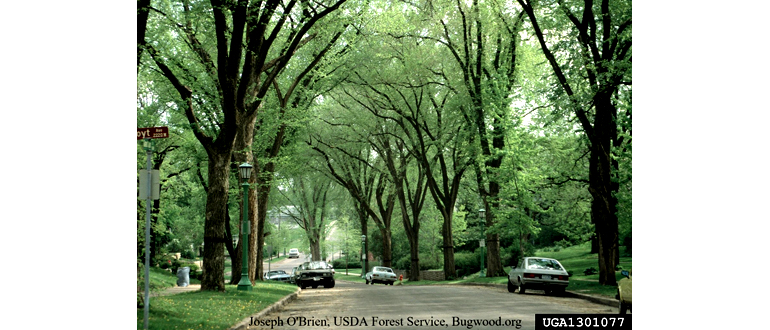
By Colleen Sturm
6/3/2020 Livonia
As a young child in the early 1960’s, I lived near the Ford Rouge plant and the Marathon oil refinery. For me, the river was nothing more than an ugly, polluted industrial channel that was avoided at all costs. That mindset stayed with me through the decades, and I never paid much attention to the river. I only became involved with FOTR a year ago after attending a Rain Gardens 101 presentation at the library.
I am a gardener, and about 10 years ago I became an enthusiast of gardening with native plants. I try to garden for birds, bees, and butterflies. When my friend suggested we attend the Rain Gardens 101 presentation, neither of us even knew what a rain garden was. During the presentation, Matthew Bertrand (FOTR Restoration Coordinator) explained the problems with rain run-off in suburban and urban areas. He showed how the vast loss of the urban tree canopy from the 1960’s through today contributed to so many environmental, flooding, and pollution problems. He presented the need for new solutions – such as rain gardens and demonstrated how important proper native plant cover is to all aspects of watershed health.
My big takeaway from the presentation was the discussion of tree canopy loss. It was a powerful message for me because I remember the wonderful tree canopy of Detroit in the 1960’s. For those too young to remember, Detroit (and the inner suburbs) was once covered by beautiful and majestic American Elm trees. It was amazing, and there is nothing like it today. I remember beautiful streets lined on both sides by regal elms that created leafy cathedral ceilings. It wasn’t just a few streets; it was most streets. I grew up under that canopy, and I loved it. I also remember the loss of it.
I was born in 1959, and for all my early years (1959 – 1967, I think) DDT was sprayed from helicopters. (We had to run inside if the sprayers came.) The government authorized widespread DDT spraying over Detroit (and the inner suburbs) to try to stop invasive beetles from spreading Dutch Elm disease. It was a bad time. DDT was so widely used back then that birds were dying off, and Rachel Carson wrote the famous “Silent Spring” book in protest.
I remember the summer the trees were cut down on our street. Dutch Elm disease claimed our street sometime around 1971. All the trees died, and all the trees were cut down – at the same time. The overnight change was devastating. It has been many decades, but I still miss the trees. What has been planted since has never compared in magnitude and beauty.
The elms are gone, but FOTR has been trying to preserve, protect and restore the Rouge River watershed since 1986. I hope to help a little.

By Orin Gelderloos
5/20/2020 Dearborn
My experiences with the Rouge River watershed began intensely in 1971 when I directed a National Science Foundation grant for high school and middle school science teachers at the University of Michigan-Dearborn. Our group took a canoe trip on the River from the Henry Ford Estate to the Rouge Plant before the concrete channel was installed in 1975. We saw Great Blue Herons and Red-tailed Hawks and Belted Kingfishers perched in the trees. Floating down the River with us were green algae mats, up to a square foot in size, that grew on nutrients from the human sewage being discharged into the River from the combined sewer overflows (of course the odors went along with the sewage mats). Since that time, I have had the opportunity to teach numerous classes and study groups about the Rouge River as a watershed as well as lead bus tours of the landscape which comprises its drainage system. I introduced a graduate course on Watershed Analysis at the University as well. Currently, I am analyzing vascular plants and the groundwater levels of the various ecological communities of the floodplain on the UM-D campus.
The Rouge River is an excellent watershed for a Friends group because of the diversity of urban and rural people living in it. Furthermore, with its modest size of 467 square miles, we can “get our arms around it.” Yet it has all the complexities that the United Nations has with differences in ethnicities, languages, income and education. Friends of the Rouge with its dedicated staff is a model non-profit organization of which I am pleased to be a member. I look forward to the time when our watershed can be a leading and unifying political entity for all the 47 communities in it.
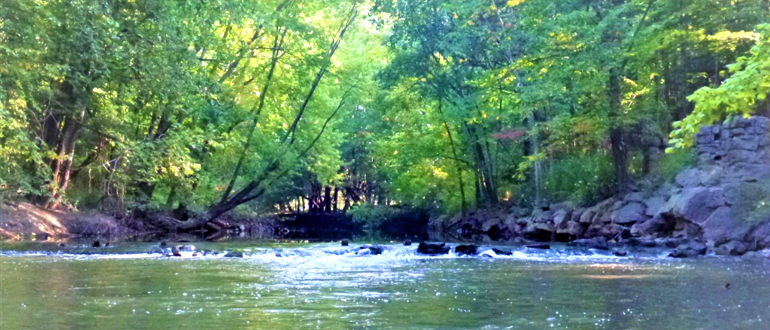
By John Covert
5/4/2020 Livonia
My Parents purchased a new home on West Parkway in 1947 when I was age 5. Our house was just north of Ann Arbor Trail. The Middle Rouge, called “The Crick” ran beneath a steep bank paralleling Ann Arbor Trail. I was fascinated by the Crick, I took my life in my hands every time I crossed Ann Arbor Trail, not because of the traffic but because my parents had forbidden me from playing there. A couple of years later, a neighborhood girl was lost falling thru the ice.
Throughout the ensuing years my family took regular Sunday rides along Hines Drive which then ran from Merriman Rd. to Northville. Over the years, Hines Drive progressed to the east, making stops at Telegraph Rd. and Outer Drive eventually reaching Ford Rd. in the late sixties. To a young kid Hines Parkway was like a wilderness, a continuous corridor of woods and water stretching for miles. When I started recreational flying as a retirement project I was shocked to discover that the parkway was merely a thin membrane of vegetation stretching thru miles and miles of, forgive me, urban wasteland. That is one of the reasons why I was so disappointed to see Wayne County selling parkland and mill sites to developers.
One fifties summer, I heard chainsaws and heavy machinery coming from the direction of the Crick. I took a seat at the top of the ridge and was fascinated to witness bulldozers and drag lines cutting a straight path across an extensive oxbow. An ecological catastrophe today but a fantastic triumph of engineering for a child of the fifties. If you drive Hines and observe carefully, you can find remains of many oxbows across from stretches of the river that appear unusually straight, the oxbow that ran upstream from Warren Rd. is still very prominent.
Life took me away from the Rouge during the sixties with Naval service and college at M.S.U. then brought me back when I was assigned a science teaching job at Whittier J.H. (now Cooper Elementary) across from an eventual Super Fund dumpsite (then Cooper Elementary) along Ann Arbor Trail, between Inkster Rd. and Middlebelt Rd. My classes made many rushed hikes (50 minutes) over to the big hill and along the Crick. We were amazed to find a beautiful grove of Pawpaw trees a little west of Inkster Rd. and the field next to old Cooper (now demolished) was an awesome site for netting and banding migrating Bobolinks.
The eighties found me high and dry teaching electronics (not my idea) at Churchill H.S. After a few years I convinced the principal to allow me to create a two hour outdoor education block. Once a week I was able to cram 18 kids into the back of a pick-up camper (never happen in this century) and make a short drive to the Holliday Nature Preserve. I was back on the Rouge (Tonquish Creek). With some help from fellow staff members, I was able to recruit 200 to 300 students every spring for the Rouge Rescue. Thirty to forty wildly enthusiastic kids pulling on an old ski resort tow rope could do quite a job on some of the log jams. Bill Craig (FOTR technical expert) was a big part of those efforts but he has since found more constructive applications for log jams.
I retired from teaching twenty years ago but never missed a Rouge Rescue, at least not until this year.

By Kathy Ableson
4/22/2020 Birmingham
Q: How did you get involved with Friends of the Rouge?
A: It was actually my son’s idea. He wanted to do something to help the environment for a school service project so we both signed up for the Frog and Toad Survey. I remember being so impressed by Sally Petrella’s training session, I left thinking this was an organization I’d really like to be a part of. Plus, it was kinda cool going out at night with my son to stand in the stillness at our listening posts. Beautiful spring evenings, citizen scientists, what could be better?
Q: What made you decide to create Froggyvoice?
A: Well, I started off with lots of enthusiasm for surveying but sadly, I wasn’t very good at it. I just had a hard time remembering which calls were which frogs once I got in the field. This was back in the day when the only real choice was to learn the calls from a CD. Luckily my son was much better at it so we were okay with our reporting. But then years later, when I was looking around for a way to test some new app technology I’d been working with, I thought of field help for frog and toad surveyors.
Q: Why is it called Froggyvoice anyway?
A: When you go to get a new domain name, obviously it has to be unique. But all the names having to do with frogs and calls and Michigan were already taken, even if they weren’t active. So I had to get creative and Froggyvoice just popped into my head. Which was fortunate really because the name gave me license to have fun with it, to draw bright colorful frogs and make them bounce when you tap the arrow. It was originally supposed to be just a small test app, maybe our seven SE Michigan frogs and our one toad, but each time I showed it to the subject experts, Sally Petrella, James Harding, Ian Ableson, and Jess Getschman, they persuaded me to add just that one more feature. They wanted all the Michigan frogs, identifying characteristics, info sheets, everything! It’s really because of them that the app is as comprehensive as it is, but I hope it can help other surveyors out there or anyone else learning about Michigan frogs and toads.
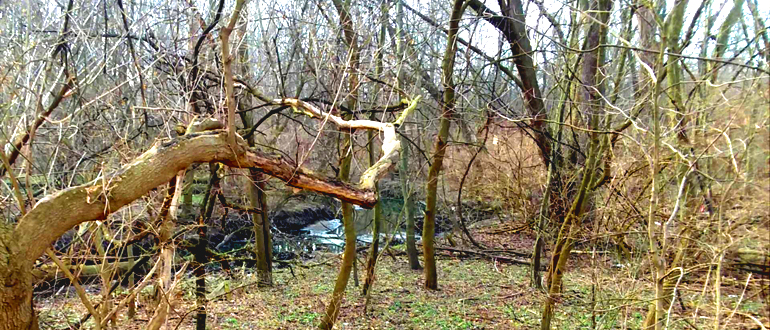
By Paula Trilety
4/8/2020 Detroit
Sally Petrella inspired me to get involved with supporting Friends of the Rouge. That and the fact that I grew up 1/2 block from Rouge Park and now live on W. Parkway, which abuts the park.
As a kid, our Ann Arbor Trail science teacher, Virginia Bohenek, took us on regular forays throughout the park and to the Nature Center in Rouge Park. We all developed a healthy respect for the environment under her watchful eye. The river, being a major attraction of the park, was closely observed during heavy downpours and major flooding.
The story of the Rouge River catching on fire about 20 years before was heart breaking to a kid who grew up in close proximity. Donating and promoting the Friends of the Rouge is the least I can do as I am indebted to all of the staff for their diligent efforts and success in cleaning up “my” river.
By Paul Draus
3/23/2020 Dearborn
Paul Draus, FOTR Board Member & Sociology Professor at UM Dearborn, shares his Rouge River story. We all have a story to tell; why we are passionate about the Rouge River, how we got involved with FOTR…Share Yours Today!
Categories
-
 BlogRead the latest blog posts from your FOTR team.
BlogRead the latest blog posts from your FOTR team. -
In the NewsClick to read news articles that feature FOTR and Your Rouge River.
-
News & EventsLearn more about upcoming FOTR events and projects